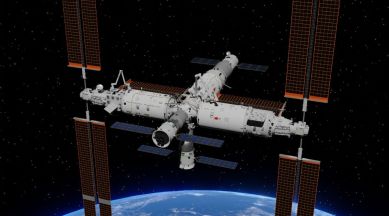China to double the size of its space station, offering alternative to ISS
China is set to double the size of its Tiangong space station in the coming years by adding three more modules to its existing three.

China plans to expand its Tiangong space station by adding another three modules to the three that are already in orbit. This expansion of the outpost’s capacity and capabilities could make it a viable alternative to the International Space Station for in-orbit experiments and missions.
The future plans for Tiangong were presented at the 47th International Astronautical Congress in Baku on Wednesday, reports SpaceNews. “We will build a 180 tons, six-module assembly in the future,” said Zhang Qiao of the China Academy of Space Technology during the event. Even after the addition of the six new modules, Tiangong will only weigh about one-third of the ageing International Space Station.
Before that, an expansion module with six docking ports will be launched to the space station in the coming years. This multi-functional module will dock at the forward port of the core Tianhe module. This means that full-size modules can then be added to Tiangong.
The Tiangong space station
The Chinese space station has three modules—the Tianhe core module (“heavenly river” crew module and the laboratory cabin modules Wentian (“quest for heavens”) and Mengtian (“dreaming of heaven”). It has been operational since late 2022, hosting up to three astronauts at a time.
The first module of the space station was Tiange, and it was launched into orbit on April 29, 2021. This contains living quarters for three crew members and provides most of the space station’s key functionalities, including power, propulsion, guidance, navigation and life support systems. The Tianhe module also has a “Chinarm” robotic arm.
The Wentian science module hosts added navigation, propulsion and orientation controls as a backup for some of Tianhe’s functions. It also acts as a pressurised environment where researchers can conduct zero-gravity experiments. Some experiments can also be conducted outside of this module, like those that measure the effects of exposure to solar winds, cosmic rays and other space conditions. Wentian also has a robotic arm called “indexing arm.” It launched and then docked with Tianhe on July 24, 2022.
Mengtian is the third module of Tiangong, and it was mainly designed for science experiments. It carried many cutting-edge physics experiments when it launched, including a facility that China claims can create the coldest matter in the universe. Mengtian launched into orbit and docked with the rest of the space station on November 3, 2022.
The Mengtian module completed what was initially supposed to be the full configuration of the Tiangong space station. But now, it is clear that China plans to expand on it further.